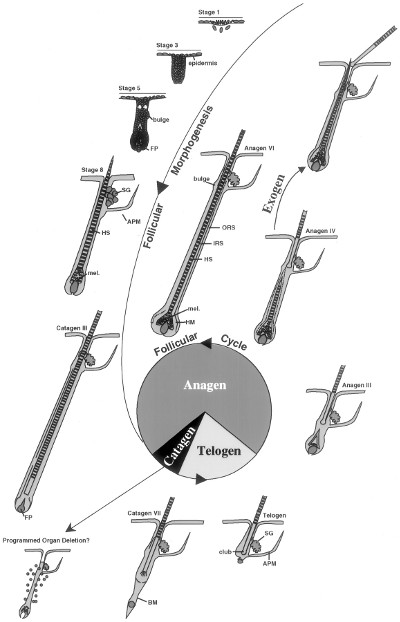Some hair especially body hair regrows after trimming but stops growing after a while. What is the mechanism behind control of hair growth and how is the length limit determined?
1 Answer
Hair grows from the follicle; there is no way for the follicle to determine if the hair tip is trimmed or not. This is unlike plant shoot/root growth that happens at the tip. Also there is no signaling from tip to follicle.
Hair growth has four stages: Anagen (Initiation), Catagen, Telogen (resting) and Exogen (falling off). Initially the primary follicle is formed during development of the skin, after that the hair growth continues in a cycle. In other words the old hair shaft is replaced by a new one. The period of the cycle (or how fast it happens determines the final hair length); the faster is the cycle the shorter will be the hair (you may note that certain people have a very short head hair even when they do not trim). This is because the old shaft doesn't get time to grow before it is shed and replaced by the new one.

From: Stenn & Paus (2001)
From the same source
Because there is a limit to the time a follicle stays in anagen, there is also a limit to the length of its product, the hair shaft. The anagen phase has been divided into six subphases (64, 359). Except for the last subphase, anagen VI (the duration of which dictates the shaft length), the length of the anagen subphases I–V does not differ substantially between follicles from different regions (490, 565).
[…]
Because the actual length of a hair follicle does not appear to dictate the length of its shaft (rather the duration of anagen determines hair shaft length), it is tempting to speculate that the subcutis offers optimal growth conditions…
[…]
Although influenced by environment (light, temperature, and nutrition) and systemic (endocrinological factors) parameters, it is generally believed that there is considerable innate local control of hair shedding; each fiber grows to a specific length, for a specific period of time, before being shed
-
$\begingroup$ Interesting. I looked at the source, and it seemed to imply that hair length is determined only by the length of time in which the hair has grown, which would assume constant growth speed. This would be a very interesting fact, I'd intuitively assume that hair (within the same animal) grows with different speed depending on body part and the current state of the body chemistry. Do you know if such difference exists, or is it a constant speed growth process? I don't remember an explicit statement from the paper, it was just an impression I got, maybe I overlooked something. $\endgroup$– rumtschoCommented Jan 10, 2015 at 19:34
-
$\begingroup$ @rumtscho Yes that happens indeed. It is mentioned in the paper. For example head hair and body hair. I also cannot find an explicit statement but it is indicated implicitly. for eg: "Except for the last subphase, anagen VI (the duration of which dictates the shaft length), the length of the anagen subphases I–V does not differ substantially between follicles from different regions" $\endgroup$– WYSIWYGCommented Jan 11, 2015 at 5:32
-
$\begingroup$ To be clear, you are implying that the only reason your hair has a limited length is that the skin itself regenerates, causing the hair to fall out? $\endgroup$– User2341Commented Sep 18, 2017 at 15:04
-
$\begingroup$ To be clear, you are implying that the only reason your hair has a limited length is that the tip of the hair "sheds" (breaks and falls off)? $\endgroup$ Commented Jan 6, 2021 at 3:19
-
$\begingroup$ @cowlinator not the tip but the root. It doesn't break. It is displaced by a new incoming hair tip. $\endgroup$– WYSIWYGCommented Jan 6, 2021 at 13:23
